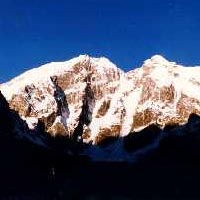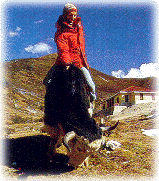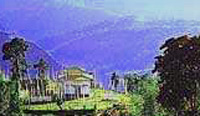| Destinations
|
|||||||||||||||
Wrapped in mists and clouds. A garden state with an incredible variety of orchids, rhododendrons, gladioli and a host of other flowers. Tumbling streams and torrents. Mountain monasteries and quaint shopping plazas. The land of the mighty Khangchendzonga. This is the second smallest state of India, Sikkim, nestled in the heart of the Himalayas. Small but beautiful, Sikkim is situated in the Eastern Himalayas. Spread below Mount Khangchendzonga (8534 mts.), the third highest mountain in the world, which is revered by the Sikkimese as their protective deity, Sikkim shares her borders with Tibet in the North, Bhutan in the East, Nepal in the West and the Indian state of West Bengal in the South.
|
More about Sikkim • Geography • History • People & Culture • Economy • Festivals • Off the Beaten Track • Wild Life • Adventure • Monastery Magic • Gangtok • Tourist Information • Accommodation • Getting There • Climate • FAQ
Travelogues
Trekking
| ||||||||||||||
With an area of 7,300 sq. kms and measuring approximately 115 kms from north to south and 65 kms from east to west, the elevation ranges from 244 mts. to over 8540 mts. above sea-level. Amidst the grandeur of the mountain peaks, lush valleys, fast flowing rivers and terraced hills, Sikkim offers a spectacular and unique experience. Within a matter of hours one can move from the sub-tropical heat of the lower valleys to the cold of the rugged mountain slopes that reach upto the areas of perpetual snow. Wander through mountain meadows, cascading rivers or densely forested ridges. Lose yourself in the romantic solitude of the mountains. Float the rivers on a raft or seek out wildlife. In the course of your wanderings, watch the electric blue butterfly or hear the thrush and cuckoo serenade you. Sikkim is home to woodpeckers, kingfishers and thrushes among other birds. Sikkim is home to a variety of 4000 plant species - magnolias, rhododendrons, junipers, blue poppies, primulas, wild strawberry, raspberry and exotic orchids in stunning sizes and colours. In Sikkim there are musk deers, the Himalayan black bear, the famed snow leopard, Thar yaks, wild ass, bharal or blue sheep, shapi and the symbol of Sikkim- the endangered Red Panda.
Administratively, the state is divided into four districts : North, East, South, and West. The headquarters are at Mangan, Gangtok, Namchi, and Gyalshing, respectively. Within each district the village panchayati system ensures the administration and implementation of welfare programs. Primary and secondary education is free in the state. A government-subsidized degree college located in Gangtok is affiliated to the North Bengal University in Darjeeling, West Bengal. Seats in the elected Vidhan Sabha are equally apportioned between the Nepalese and the minority Lepcha and Bhutia populations. One Lepcha-Bhutia seat is reserved for the nominee of the Lamas, or Buddhist religious leaders, and one seat of the Nepalese group is reserved for the representative of the Scheduled Castes. People and culture:
Sikkim's traditions and festivals are strongly influenced by Tibetan customs, while retaining the diversity of the ethnic groups that inhabit the land: the Lepchas, Bhutias and Nepalese. Bon, the religion preceding Buddhism, has also left behind a rich legacy of customs and rituals. The most important annual festival is the two-day Phanglhabsol festival in August or September, in which masked dancers perform in honour of the presiding deity, Khangchendzonga. The people of Sikkim love to celebrate. Be it the chasing away of evil spirits or celebrations on the occasion of the New Year, the Sikkimese do it all with refreshing abandon. Taste the 'Chaang' a preparation from fermented millet, served in bamboo containers with a hollow bamboo pipe.
Sikkimese culture finds expression in its beautiful arts and crafts. Carry back a memento of your holiday, be it an intricately carved piece of furniture (choktse), a highly embellished carpet or something made of woven bamboo. With a population of only 4.2 lakhs, concentrated in the East and South districts, West Sikkim is moderately populated whereas North Sikkim is sparsely populated. The crime rate in Sikkim is negligible and it is a very peaceful state.
The main monasteries are Pemayangtse and Tashiding in West Sikkim, Enchey in Gangtok and Ramtek near Gangtok, Ralong in South and Phodong and Tolung in North Sikkim.
Influencing the lifestyle and cultural heritage of the people, each monastery is host to a number of festivals, each of which is a fascinating experience of old-world pomp and pageantry. The lama dances, complete with fierce masks, gorgeous brocade costumes, music and chants, is at once both evocative and mysterious.
There is a lake in the midst of a luxuriant forest with not a single leaf floating on it. And if even a leaf falls a little bird picks it up ... so the legend goes. This is the Wishing Lake or Tsho-Sho-Tsho as the Sikkimese call it. The Sikkimese Nepali is the inheritor of the legacy of Hindu traditions. The visitor to Sikkim is spellbound by the colourful festivals of Dasain/Tewar celebrated by the Hindu Nepali population. Invocations are made to Goddess Durga and barley seeds are planted in prayer rooms. Their other important festival is Dipavali, a rare treat, to participate in the celebration of. Religion and spiritual values are an integral part of Sikkim's daily life. The sense of peace and calm that is palpable in this and other Himalayan regions makes a visit to Sikkim more than a holiday treat - it will remain a lifetime experience.
Compiled by Romola Butalia
|
|||||||||||||||
Editor: Romola Butalia (c) India Travelogue. All rights reserved. |
|||||||||||||||
 Just as Mt. Khangchendzonga is an indisputable part of the consciousness of the Sikkimese people, so too are the rivers Tista and Rangit with deep ravines and valleys that allow the monsoons to penetrate and nourish this garden state. Other than Mount Khangchendzonga, the best known peaks are Pauhunri (7125m), Pandim (6691m), Talung (6147m), Tent Peak (7365m), Jongsang (7459m), Rathong (6679m), Koktang (6147m) and Sinioulchu (6887m), regarded by mountaineers as the most beautiful peak in the world.
Just as Mt. Khangchendzonga is an indisputable part of the consciousness of the Sikkimese people, so too are the rivers Tista and Rangit with deep ravines and valleys that allow the monsoons to penetrate and nourish this garden state. Other than Mount Khangchendzonga, the best known peaks are Pauhunri (7125m), Pandim (6691m), Talung (6147m), Tent Peak (7365m), Jongsang (7459m), Rathong (6679m), Koktang (6147m) and Sinioulchu (6887m), regarded by mountaineers as the most beautiful peak in the world.

 The people of Sikkim are warm, simple and friendly with a natural uninhibited gaiety.
Sikkim's population consists of Lepchas, Nepalese and Bhutias. The Lepchas are the oldest inhabitants of Sikkim. There is an old Lepcha legend that long ago, the laughter of the Lepchas wafted into the sky and it scattered and froze into shimmering stars. In the 15th and 16th centuries, the Tibetans arrived bringing with them the Red Hat Lamaist tradition - Nyingmapa, which became the dominant culture and official state religion.
The people of Sikkim are warm, simple and friendly with a natural uninhibited gaiety.
Sikkim's population consists of Lepchas, Nepalese and Bhutias. The Lepchas are the oldest inhabitants of Sikkim. There is an old Lepcha legend that long ago, the laughter of the Lepchas wafted into the sky and it scattered and froze into shimmering stars. In the 15th and 16th centuries, the Tibetans arrived bringing with them the Red Hat Lamaist tradition - Nyingmapa, which became the dominant culture and official state religion.
 One of the sacred objects of worship for the Sikkimese is Bumchu a sacred pot containing holy water, blessed by a Buddhist saint in the 17th century. Today after 300 years the water remains as fresh as before.
One of the sacred objects of worship for the Sikkimese is Bumchu a sacred pot containing holy water, blessed by a Buddhist saint in the 17th century. Today after 300 years the water remains as fresh as before.